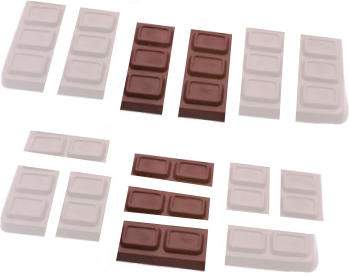By Michael Hartley
If I want half a pizza, but the pizza is cut into four pieces, how many should I eat?
To most people, getting one half of a pizza is the same as getting two quarters of the pizza. At least, we get the same amount of pizza either way! This is what we mean when we say
Let's see another example. Suppose there is a chocolate bar divided into 6 parts, and I get two, so my share is two sixths.

To test if fractions are equivalent
I can think of three methods for doing this.The first method for equivalent fractions
The first method to test if fractions are equivalent fractions is to simplify the fractions. For example, to answer this question :Which of the
fractions  ,
,  and
and  are equivalent?
are equivalent?
we can start by simplifying each fraction. For this problem,The key here is
Equivalent fractions give the
same answer when you simplify them
It's important to simplify them properly though! If you simplified 18/30
to 3/5
and 24/40 to 6/10
, you couldn't say they were not equivalent - you haven't finished
simplifying 24/40...The second method for equivalent fractions
If you put equivalent fractions over a common denominator, the results will be the same. Let's try this with the example above.If we put  and
and  over a common denominator,
over a common denominator,
we get and
and 
These are different, so the fractions are not equivalent. However,we get
if we put  and
and  over a common denominator,
over a common denominator,
we get and
and 
These are the same! So, these two fractions are equivalent. The
principle here iswe get
Equivalent fraction become the
same when you put them over a common denominator
The third method for equivalent fractions
If you are uncomfortable with the two methods above, but you like multiplying, you can try this method- Multiply the denominator of one fraction by the numerator of the other.
- Then multiply the numerator of the first fraction by the denominator of the other.
- If these two calculations give the same answer, then the fractions are equivalent fractions. Otherwise, they are not.
- 30 times 20 is 600, but
- 18 times 35 is 630, so
- These fractions are not equivalent
- 30 times 24 is 720, and
- 18 times 40 is also 720, so
- These fractions are equivalent!
If you'd like some practice working out equivalent fractions, be sure to check out the online Equivalent Fractions Quiz, or the Equivalent Fractions Worksheets on this site. Or would you like an infinite supply of Equivalent Fractions Examples? If you do the quiz or the worksheets, don't use the Equivalent Fractions Calculator to cheat!